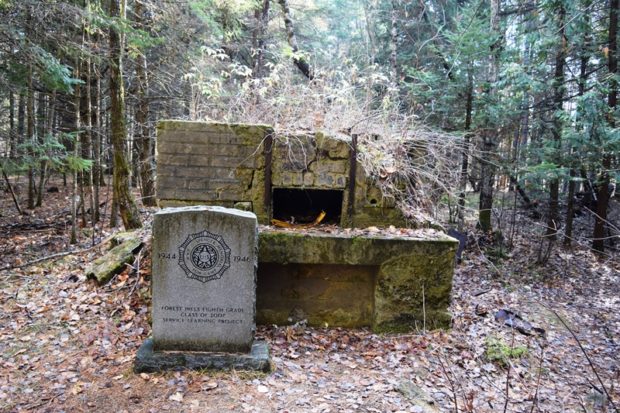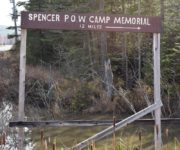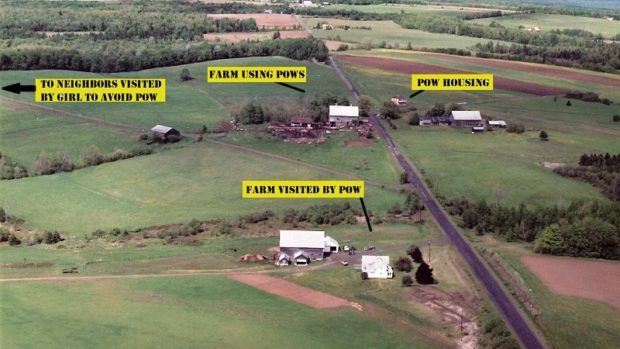
The Spencer Lake camp was built to accommodate 250 prisoners, though it later had to handle 310 men. Schoolchildren from Forest Hills School 8th Grade Class of 2007 for their service learning project in nearby Jackman have placed a plaque marking the spot near an apparent cooking structure. (See photo above.)
Maine’s forest and potato economy was struggling during World War II. Young men had either joined the armed forces or sought work out of state in the war effort industries.
Congresswoman Margaret Chase Smith and U.S. Senator Ralph Owen Brewster were promoting the placement of POWs in Maine to provide a needed workforce in the woods and on the farms. Finally, in 1944, about 4,000 German prisoners were allocated to Maine. Four camps were established: Houlton, Princeton, Seboomook, and Spencer Lake in Hobbstown Township.
 Not everyone welcomed the Germans, fearing potential escapees and resenting their part in the war. Direct beneficiaries were paper companies, such as Hollingsworth and Whitney (H&W), which were under pressure to step us production to supply critically needed war material. H&W built the Spencer Lake facility, located in Hobbstown Township, about 12 miles from U.S. Route 201 on a privately owned logging road.
Not everyone welcomed the Germans, fearing potential escapees and resenting their part in the war. Direct beneficiaries were paper companies, such as Hollingsworth and Whitney (H&W), which were under pressure to step us production to supply critically needed war material. H&W built the Spencer Lake facility, located in Hobbstown Township, about 12 miles from U.S. Route 201 on a privately owned logging road.
According to the Smithsonian Institution,
Farmers who contracted for POW workers usually provided meals for them and paid the U.S. government 45 cents an hour per laborer, which helped offset the millions of dollars needed to care for the prisoners. Even though a POW netted only 80 cents a day for himself, it provided him with pocket money to spend in the canteen. Officers were not required to work under the Geneva Convention accords, which also prohibited POWs from working in dangerous conditions or in tasks directly related to the war effort.1
The camp gained unexpected fame when three young prisoners (aged 18, 19, and 20) escaped during the early spring of 1945. They were captured five days later near West Forks and were returned to the camp. In the 1950s, one of them returned to the United States as an engineer working with NASA on the Apollo missions. He became a U.S. citizen in 1961. The Spencer/Hobbstown camp closed in 1946. A part of the camp site is now managed as a memorial.
The Houlton camp, in the midst of potato country in Aroostook County, “farmed out” young men to work for potato growers, including one on the Golden Ridge Road in the town of Sherman.
“Fred Corliss and his wife Ella had POWs work in their potato fields under guard from US soldiers. This farm was located on Golden Ridge in Sherman Mills at the end of the so-called Prairie Road. At the time, church and parsonage buildings existed on the Prairie Road side of Golden Ridge and the parsonage which was not occupied was used as a type of barracks or housing for the POWs.” *
Farm hand POWs had a less restrictive security level than some in logging camps. A single guard was assigned to the Sherman site.He later married the farmer’s daughter. One of the POWs visited a nearby farm to introduce himself to a young lady there. She was surprised and nervous, but agreed to meet him at her house at another time. However, she got cold feet and went to visit neighbors to avoid him. Later he left a note scolding her for not following”proper decorum” when making arrangements to meet a person. (Sherman farm sites below.)
 In the spring of 1944, the federal government turned the Civilian Conservation Corps camp at Princeton into a prisoner of war camp. Many of the former CCC buildings were converted into dormitories and other uses. A 6 foot electric barbed wire fence was installed around the entire camp and outside the electric fence were two other fences. The camp closed formally in 1946. The Passamaquoddy Tribe purchased the land that included the POW Camp from the private landowners in the 1980’s as part of the settlement act. In 2013, the site was used for residential purposes, as a watershed, and for wildlife habitat along Lewey Lake.2
In the spring of 1944, the federal government turned the Civilian Conservation Corps camp at Princeton into a prisoner of war camp. Many of the former CCC buildings were converted into dormitories and other uses. A 6 foot electric barbed wire fence was installed around the entire camp and outside the electric fence were two other fences. The camp closed formally in 1946. The Passamaquoddy Tribe purchased the land that included the POW Camp from the private landowners in the 1980’s as part of the settlement act. In 2013, the site was used for residential purposes, as a watershed, and for wildlife habitat along Lewey Lake.2
Videos!
Additional resources
*Anecdote from Eula Roberts, a descendant of Frank and Ella Corliss.
Doiron, Paul. “Hobbstown POW Camp.” May 15, 2011. [includes photos] http://www.pauldoiron.com/blog/2011/5/15/hobbstown-pow-camp.html (accessed November 17, 2016)
1Garcia, J. Malcom. “German POWs on the American Homefront.” smithsonian.com. September 15, 2009. http://www.smithsonianmag.com/history/german-pows-on-the-american-homefront-141009996/?no-ist (accessed November 17, 2016)
Joseph, Ron. “Escape from Spencer Lake.” Downeast. December 2014. pp. 95-97, 110, 112, 114.
2Passamaquoddy Historic Preservation Office. “A Brief History of the Prisoner of War Camp at Indian Township.” September 4, 2013. http://www.wabanaki.com/September%202013%20Newsletter%20POW%20project.pdf (accessed November 17, 2016)

